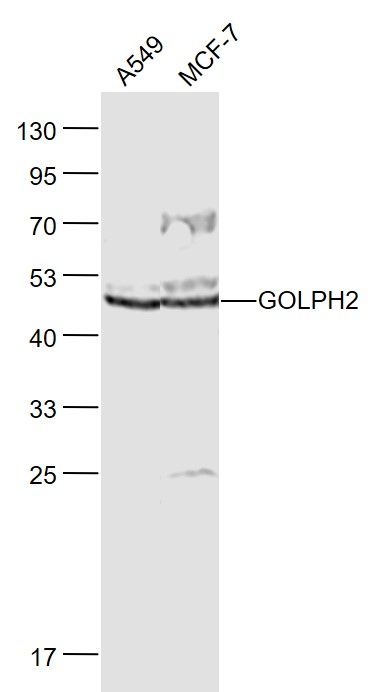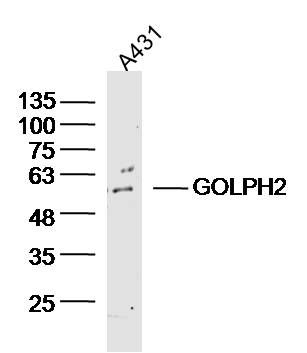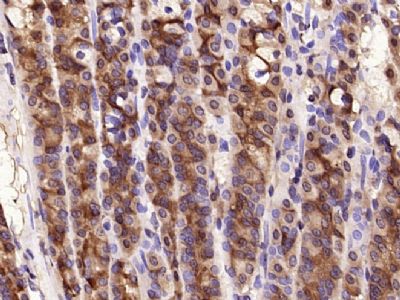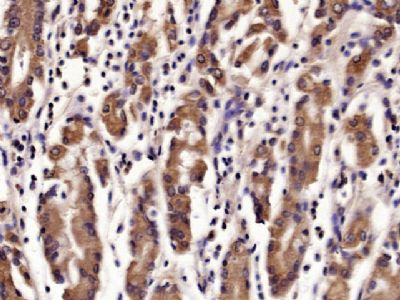GOLPH2 is widely expressed. Expression levels are high in the colon, prostate, trachea and stomach; expressed at lower level in testis, muscle, lymphoid tissues, white blood cells and spleen. GOLPH2 is predominantly expressed by cells of the epithelial lineage. It is expressed at a low level in normal liver, though expression significantly increases in virus (HBV, HCV) infected liver. Expression does not increase in liver disease due to non viral causes (alcohol induced liver disease, autoimmune hepatitis). Increased expression in hepatocytes appears to be a general feature of advanced liver disease. In liver tissue from patients with adult giant-cell hepatitis (GCH), it is strongly expressed in hepatocyte derived syncitial giant cells. GOLPH2 is constitutively expressed by biliary epithelial cells but not by hepatocytes.
Function:
Unknown. Cellular response protein to viral infection.
Subcellular Location:
Golgi apparatus, cis-Golgi network membrane. Early Golgi. Cycles via the cell surface and endosomes upon lumenal pH disruption.
Tissue Specificity:
Widely expressed. Highly expressed in colon, prostate, trachea and stomach. Expressed at lower level in testis, muscle, lymphoid tissues, white blood cells and spleen. Predominantly expressed by cells of the epithelial lineage. Expressed at low level in normal liver. Expression significantly increases in virus (HBV, HCV) infected liver. Expression does not increase in liver disease due to non-viral causes (alcohol-induced liver disease, autoimmune hepatitis). Increased expression in hepatocytes appears to be a general feature of advanced liver disease. In liver tissue from patients with adult giant-cell hepatitis (GCH), it is strongly expressed in hepatocyte-derived syncitial giant cells. Constitutively expressed by biliary epithelial cells but not by hepatocytes.
Post-translational modifications:
Glycosylated.
Phosphorylation sites are present in the extracelllular medium.
Similarity:
Belongs to the GOLM1/CASC4 family.
SWISS:
Q8NBJ4
Gene ID:
5256
Database links:
Entrez Gene: 5256 Human
Entrez Gene: 105348 Mouse
Entrez Gene: 306725 Rat
Omim: 601364 Human
SwissProt: Q8NBJ4 Human
SwissProt: Q91XA2 Mouse
Unigene: 494337 Human
Unigene: 171335 Mouse
| Picture |
Sample:
A549(Human) Cell Lysate at 30 ug
MCF-7(Human) Cell Lysate at 30 ug
Primary: Anti- TBX1 (SL4887R) at 1/1000 dilution
Secondary: IRDye800CW Goat Anti-Rabbit IgG at 1/20000 dilution
Predicted band size: 45 kD
Observed band size: 45 kD
(human/cell line)A431 lysates probed with GOLPH2 Polyclonal Antibody, Unconjugated (Catalog #SL4887R) at 1:300 overnight at 4ⅹC. Followed by a conjugated secondary antibody (Secondary Catalog #926-32211) at 1:10000 for 60 min at 37ⅹC.
Paraformaldehyde-fixed, paraffin embedded (rat stomach tissue); Antigen retrieval by microwave in sodium citratebuffer (pH6.0) ; Block endogenous peroxidase by 3% hydrogen peroxide for 30 minutes; Blocking buffer (3%BSA) at RTfor 30min; Antibody incubation with (GOLPH2) Polyclonal/MonoclonalAntibody, Unconjugated (SL4887R) at 1:400 overnight at 4℃,followed by conjugation to the secondary antibody (labeled with HRP)and DAB staining.
Paraformaldehyde-fixed, paraffin embedded (human stomach tissue); Antigen retrieval by microwave in sodium citratebuffer (pH6.0) ; Block endogenous peroxidase by 3% hydrogen peroxide for 30 minutes; Blocking buffer (3%BSA) at RTfor 30min; Antibody incubation with (GOLPH2) Polyclonal/MonoclonalAntibody, Unconjugated (SL4887R) at 1:400 overnight at 4℃,followed by conjugation to the secondary antibody (labeled with HRP)and DAB staining.
|
|
|



